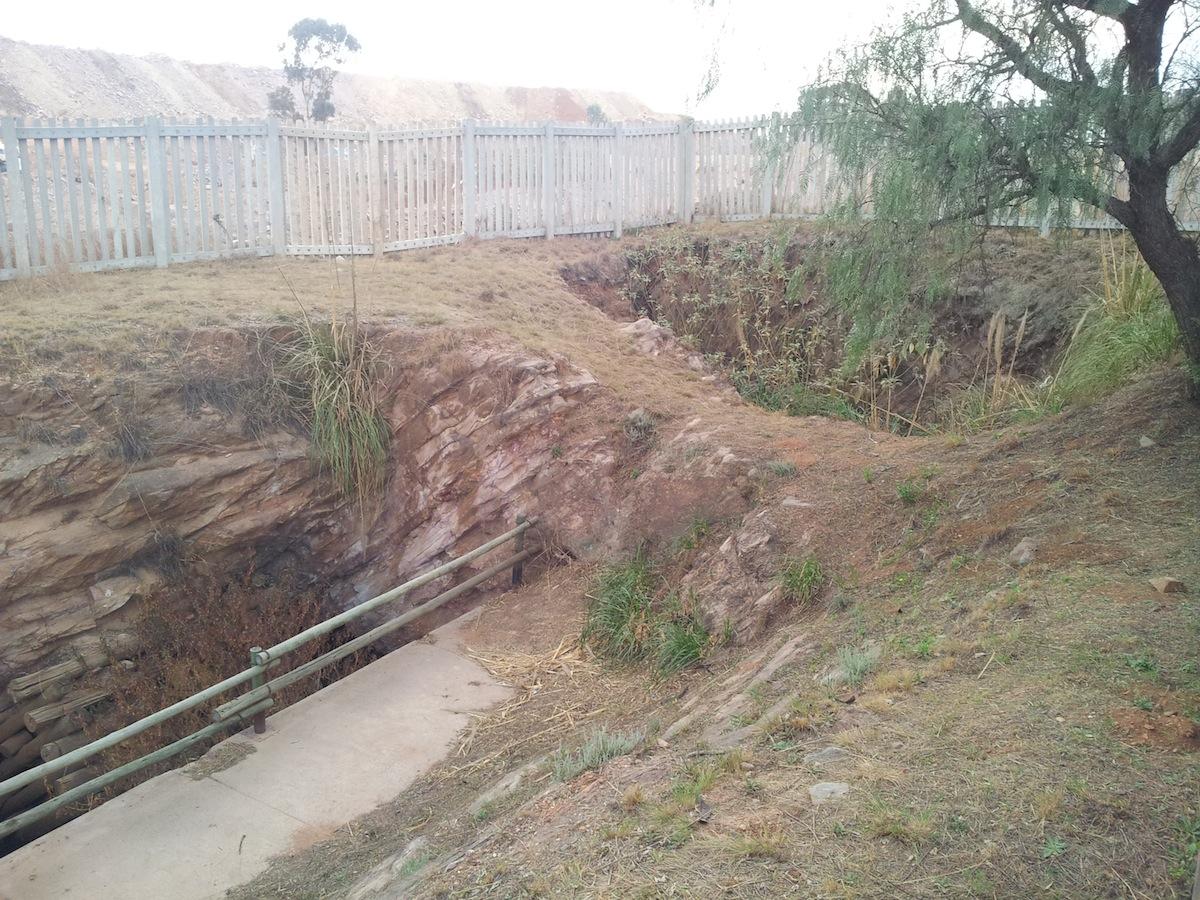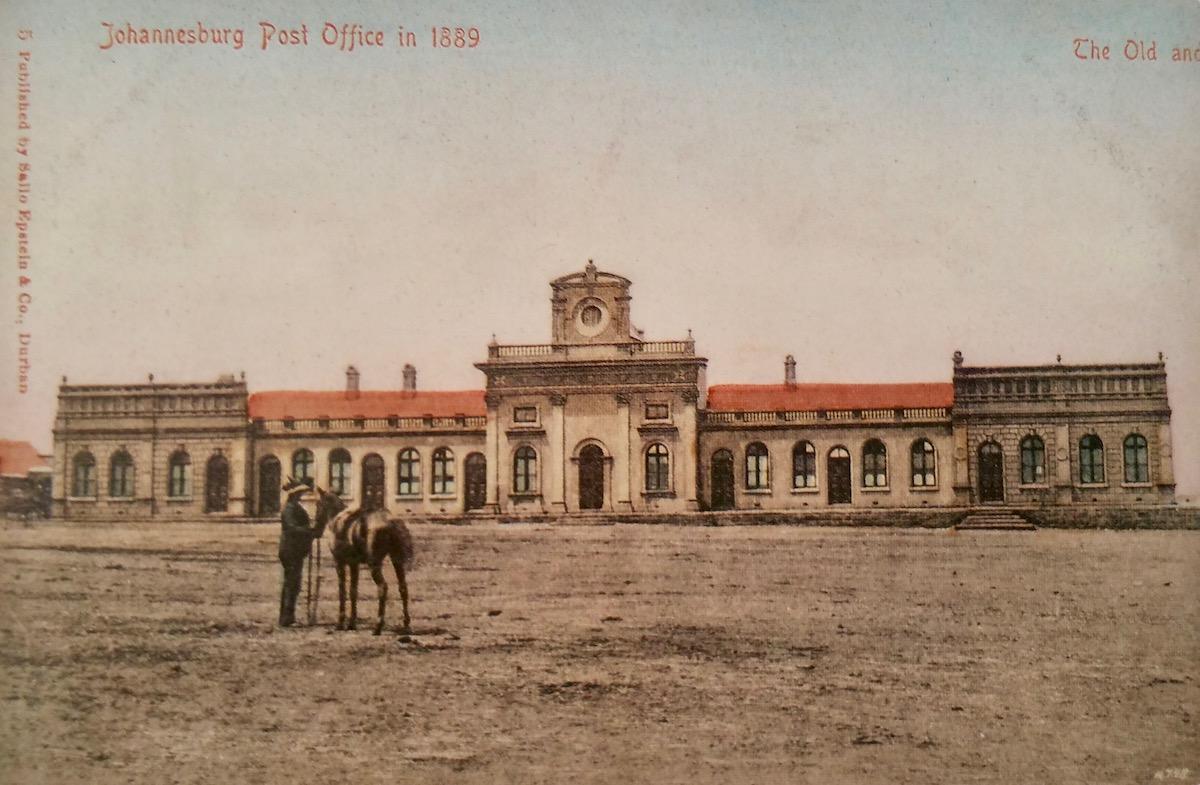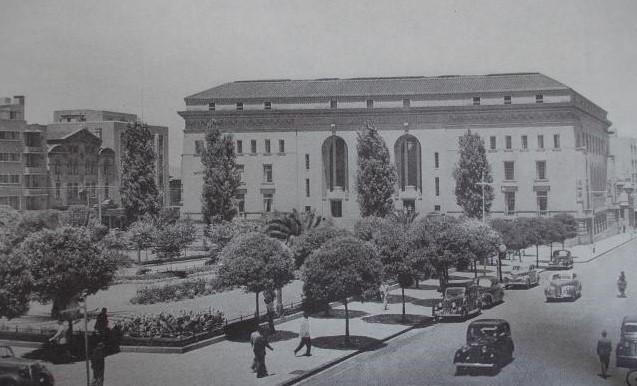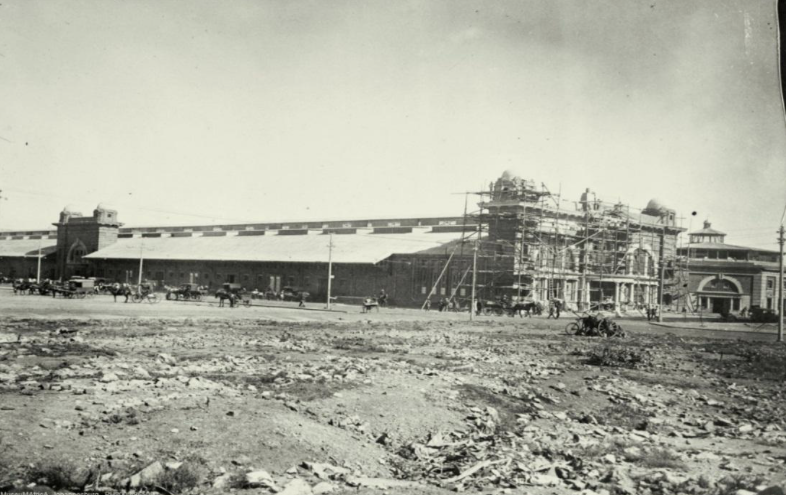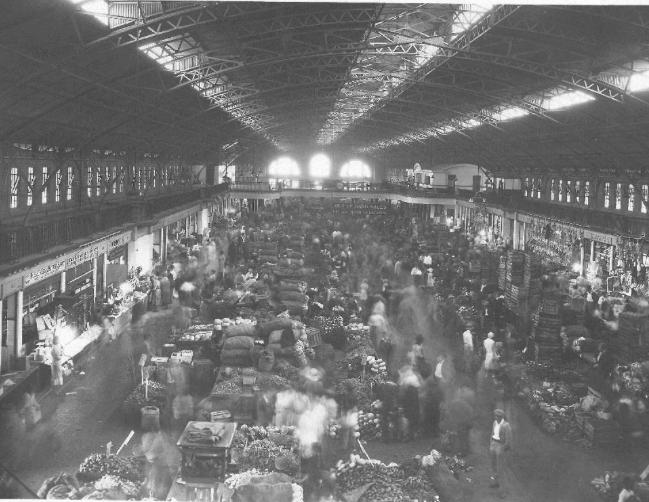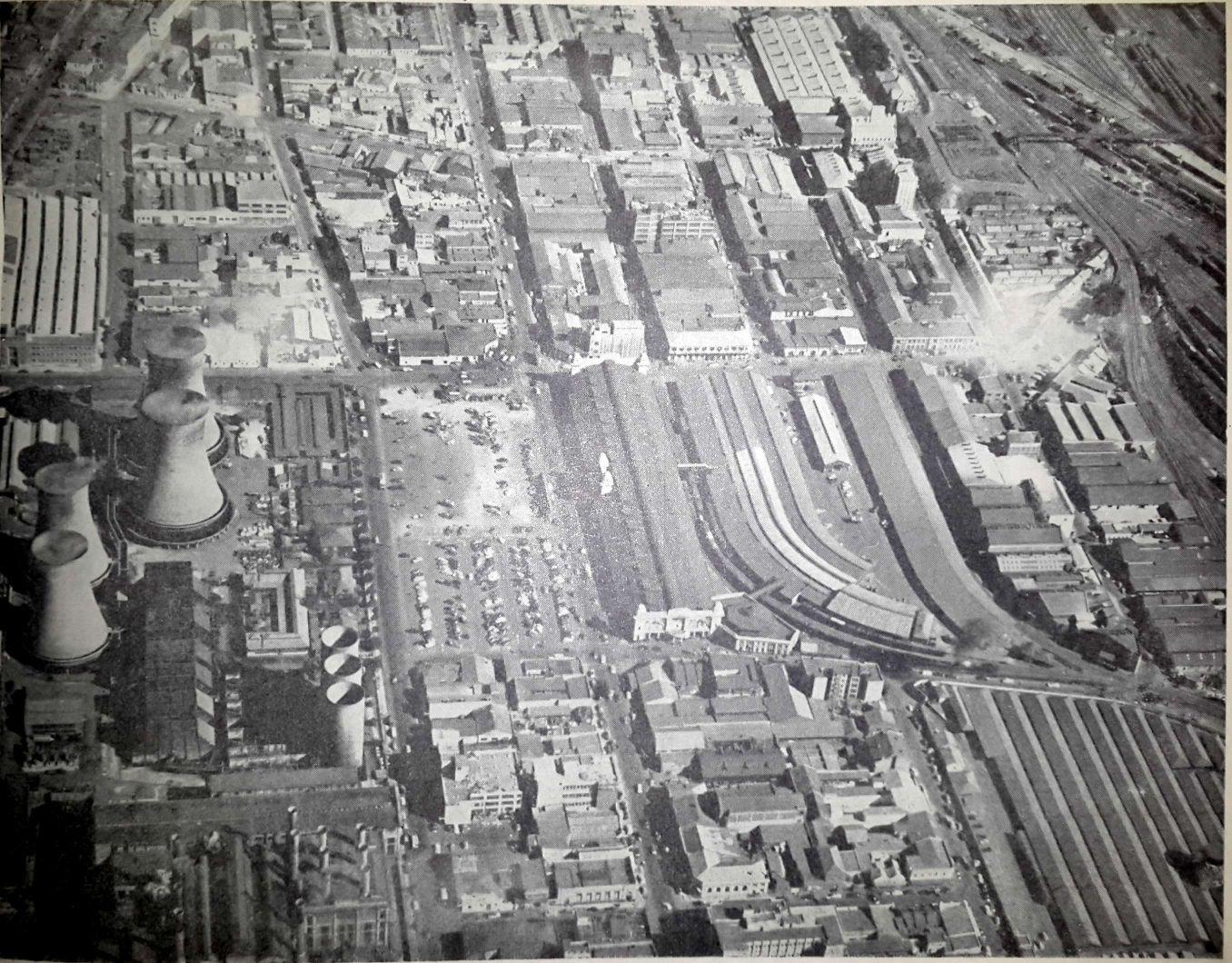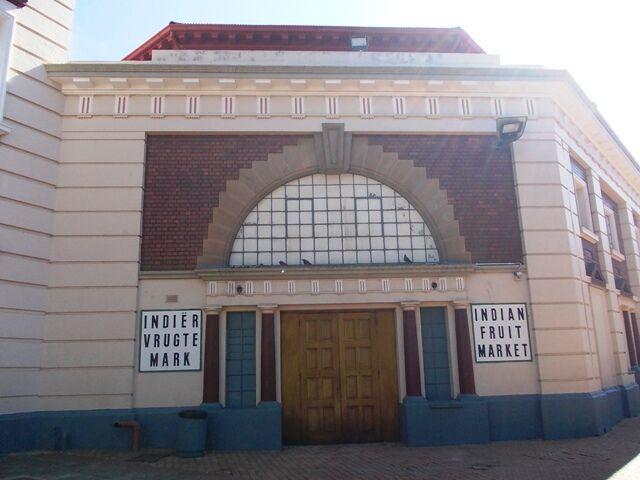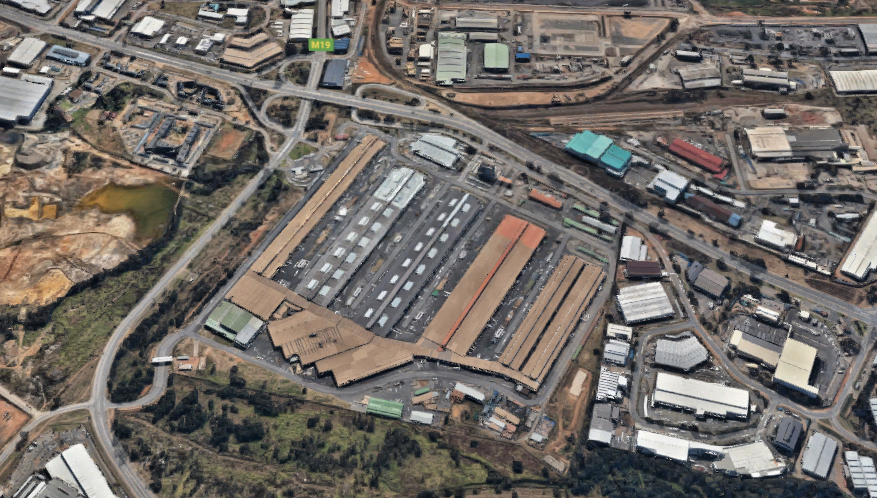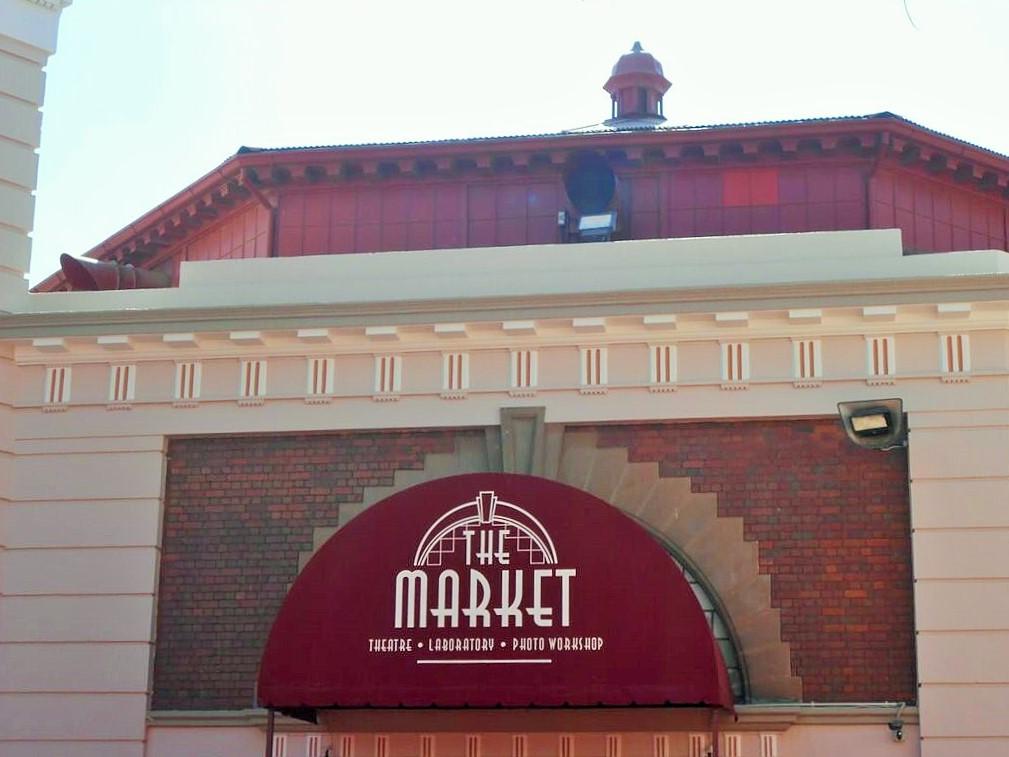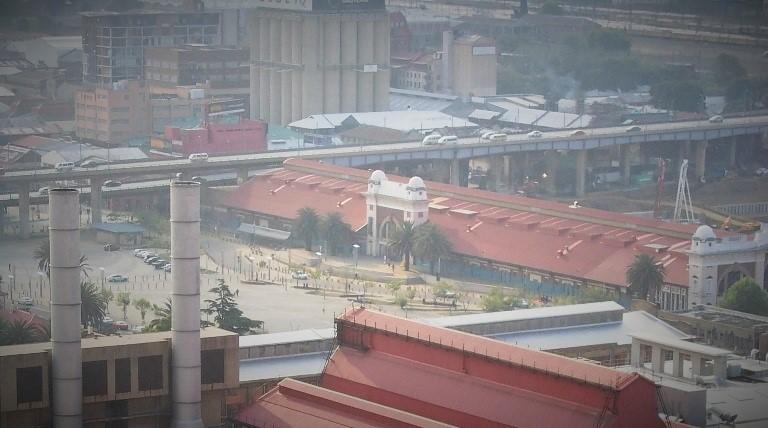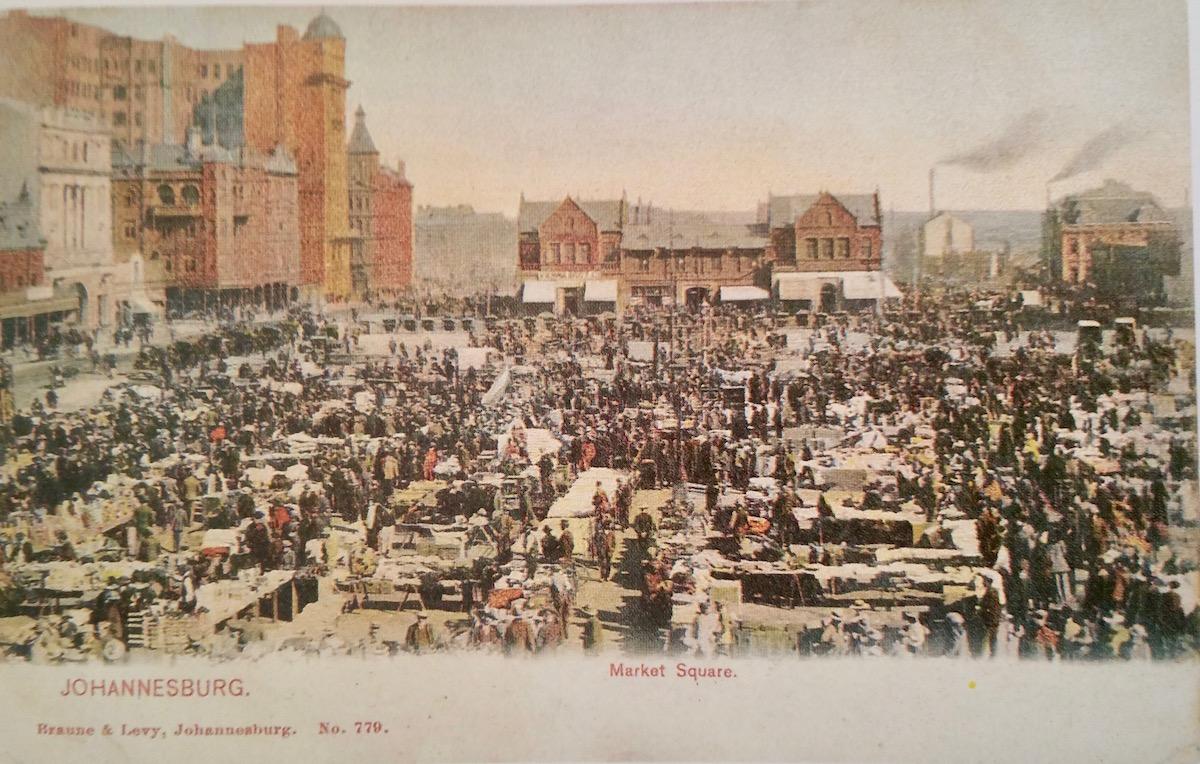
Disclaimer: Any views expressed by individuals and organisations are their own and do not in any way represent the views of The Heritage Portal. If you find any mistakes or historical inaccuracies, please contact the editor.
The article below, written by journalist and Joburg explorer Lucille Davie, looks at the layered history and significance of Johannesburg's markets over the years. It was originally published on the City of Johannesburg's website on 9 January 2004. Click here to view more of Davie's work.
Just 118 years ago the Johannesburg CBD was flat, patchy grassland, interspersed with rocky outcrops and an occasional stream and one or two farmhouses. Then gold was found in 1886 and a town was born, taking its shape from the largest square in the country, market square.
The old mining works at the site where the main reef was discovered (The Heritage Portal)
Six blocks in all, market square stretched from Rissik Street in the east to Sauer Street in the west, bordered by President and Market streets. According to Johannesburg – One Hundred Years (1986), “Depending on the weather, the square and streets were either unattended dustbowls or strips of churned-up mud dotted with pools. There were always wagon tracks and horse and ox droppings.”
The eastern portion of the square became a produce and general dealers’ market, while the western half was a cattle market.
By 1895 shops, offices, and banks appeared on its perimeter. In 1888 a market house was built, and together with a shelter housing the town’s first fire-fighting apparatus, it was the first building in the space.
The town’s first government building was built on Rissik Street on the eastern edge in 1888. It was a low, flat building with arched windows and a central balcony and square frontispiece, with the post office occupying one wing. In 1892 the entire building was taken over by the post office, serving them for eight years before a bigger building became necessary. In 1897 the present post office was built, and in 1905 another floor and a clock tower were added.
Postcard of the Post Office in 1889 (A Johannesburg Album)
In 1906 the city council took over control of the market, with the aim of eventually building government and municipal buildings on the square.
As a result, an area north-west of the town, known as Brickfields because its marshy ground was ideal for making bricks, was identified as a suitable site to relocate the market. An outbreak of bubonic plague was used as an excuse to move the mixed community living there, and, once they were relocated, the area was torched and levelled. It was to be called Newtown.
By 1910 building had started on the present City Hall (opposite the post office), and in 1915, according to Naomi and Reuben Musiker in A Concise Historical Dictionary of Greater Johannesburg, a small park was laid out in the western section of the square, called the Market Square Gardens.
Johannesburg City Hall under construction (wikipedia)
In the same year the City Hall was opened and the square changed its name to the City Hall Gardens. In 1935 an imposing central library building was opened on the western edge, and in 1939 the square’s name changed again - to the Library Gardens. Later that year the name was changed to the Harry Hofmeyr Gardens, to honour the town’s mayor from 1911 to 1912. And today it is the Beyers Naude Square and development continues – in February this year the Gauteng province bought the square (it bought the City Hall in 2001), and is proposing expanding the square by demolishing up to 10 adjacent inner-city buildings. [Editor's note - Click here to for more recent updates on the Kopanong Precinct]
Old photo of the Johannesburg Public Library (South African Builder Magazine)
The Newtown market
An area of 27 acres was surveyed and a large market hall, some two blocks in length, was built at the western end of Bree Street, opened in 1913. The tramway system was extended from the town centre to Newtown, and further westwards to Vrededorp and Brixton. Railway sidings were brought around behind the hall.
Newtown Market Building nearing completion (Museum Africa Archives)
Unusually, no national competition was held to find a design for the building and draughtsmen from the City Engineer’s Department were called on for ideas instead. The result is impressive: a long half-moon shaped building, with large striking, domed-topped corner columns, and an unrestricted interior space of over 200m in height and 37m in width. It was the largest building of its kind in South Africa, and cost R230 000 to erect.
Inside the Newtown Market (Museum Africa Archives)
Gerhard-Mark van der Waal, in From Mining Camp to Metropolis (1987), describes it: “The huge iron construction of the roof with its ‘three-pointed arches’, is indicative not only of local advances in building techniques but probably also of the effect mining constructions were beginning to have on urban (industrial) architecture.”
The building consisted of a market hall in which fruit, vegetables, flowers, butter, eggs, fish and meat were sold. Behind the main hall was a grain and forage section, a poultry market and a meat market annex. The complex contained 41 shops, a restaurant, bank, post office and railway office. South of the building was a large open space, known as the “Outspan”, and where a wagon market was conducted, with farmers being provided with accommodation for their wagons and stock. In time this became a parking area, accommodating up to 500 cars. The total area, including abattoirs, consisted of 25 acres of land, with a further two acres for the nearby forage and grain markets.
Newtown from above (Seventy Golden Years)
”The aim of the Municipality was to provide a market in direct contact with the railway, adequately served by the tramway system and convenient in situation to all interested parties so that the producer could place his goods on the market at the minimum of cost and trouble while the consumer was able to obtain supplies with ease and convenience,” says TF Thurgood, market master and author of The Johannesburg Municipal Produce Market (1964).
Thurgood explains that the market occupied “a unique position among markets in the Union in that it has developed into a national market, its produce being distributed to other parts of South Africa including many of the smaller wholesale and retail markets . . .”. This is still the case at the city’s new market at City Deep which was moved from Newtown in 1974.
The daily traffic of produce in 1964 was 2 000 tons, according to Thurgood, delivered to the market from as far away as the Cape. The wholesale turnover figure in the same year was over R16-million. The market catered for both wholesale and retail customers, with the wholesale section situated on the eastern end of the market, with produce sold by auction in what has been converted into the main theatre of the market square.
A friendly market
“The market is, therefore, of vital importance to the economy of South Africa and the public it serves. But, in spite of its importance, it remains a friendly market; for here all nationalities meet, and while the stern and heavy dealings with the wholesale trade are in progress, the market doors are also wide open to the general public. Shopping is easy, too, for there are shops and stalls within the market offering the widest choice,” according to Felix Start in Seventy Golden Years, 1886-1956 (1956).
The retail market comprised the main hall of what is now Museum Africa, with 262 “table spaces” for market gardeners and farmers who sold their produce direct to the public, plus 44 fruit and vegetable stalls, and 28 shops licensed to sell a range of foodstuffs. There was a small Indian fruit market, comprising 12 shops, reserved for wholesalers and retailers.
Like housekeepers today who pop into their nearest Food Woolworths or their local greengrocer, housewives of 50 years ago popped into the market in Bree Street, to purchase their weekly fruit and vegetable supplies at a reasonable price. Although these housewives made up only two percent of total sales on the market, for them it was an institution.
Signage for the Indian Fruit Market (The Heritage Portal)
Parcel delivery
Market management started a service which undertook to “deliver parcels of produce bought on the market anywhere in the municipal areas . . .” and in 1962/63, some “53 730 parcels of fruit and vegetables were delivered to various homes throughout the municipal area without a single parcel being miscarried”, says Thurgood. The cost to the market of each delivery was around eight cents, which was considered to be “a cheap rate”.
There were other services too. A woman could buy a live chicken and have it “slaughtered, plucked, dressed and examined by an inspector on the spot”. Even “ritual slaughter” was catered for.
Mobile markets
In 1944 mobile markets came into operation. The first mobile van hit the streets in June of that year, in response to hardships faced by households after the war. By 1950 there were seven vans operating in the suburbs, but soon afterwards losses built up, mainly because women went out to work to help balance the family budget and were not at home when the van called, and because local greengrocer shops saw the gap, together with hawkers who could deliver house to house and give credit. The service, only offered to white households in the suburbs, was eventually terminated in 1952.
Market stabilisation scheme
In 1951 the market experienced a crisis. As a result of a late highveld crop coinciding with an early one from the lowveld, the market was flooded with potatoes. The warehouse was jammed with 100 000 pockets of potatoes and an equal amount waited to be offloaded from rail trucks. The market usually moved around 25 000 pockets each day.
Management had to move fast: they decided to send the excess to the townships south and west of the city.
”All available shed space in the vicinity of the market was requisitioned and a fleet of lorries from the City Engineer’s Department transferred over 100 000 pockets of potatoes from the waiting trucks at the market to this additional accommodation. The Market Master then telephoned the various Superintendents of the Native Townships and obtained an estimate of their requirements,” writes Thurgood.
The price per pocket was 40c, upped to 45c to the consumer, the extra 5c covering transport. Although the price was uneconomical for the farmers, the Potato Board subsidised the scheme and other produce was added to the scheme – pumpkins, sweet potatoes, cabbages, tomatoes, watermelons, oranges and apples – as it was soon realised that the scheme stabilised the market, and helped reduce price fluctuations
The only drawback was that certain items, like peas, beans, gem squash, marrows and cucumbers, did not interest township housewives, but the advantages of the scheme outweighed this problem.
City Deep market
Thurgood praises the foresight of the early city fathers in providing a large enough facility to grow with the city. “How well they looked into the future will be appreciated by the fact that the marketing facilities provided in 1913 have stood the City in good stead for many years, but the time has now come when the volume of business transacted on the market has outstripped the facilities available.”
That time was 1964. A new site for the market was found at City Deep, five kilometres south of the CBD. It took 10 years to build and the fresh produce market moved there in 1976. It is now the city’s and the country’s biggest produce market, comprising 63ha where some 5 000 farmers send their produce to around 3 500 buyers, some from as far away as Angola, Botswana, Zimbabwe, Lesotho and Swaziland. Its annual turnover is R1,4-billion, with sales in a single day totalling R10,89-million. In July 2000, along with a number of other city enterprises, the market was corporatised.
The market sells fruit and vegetables, meat, fish and selected groceries in bulk and caters for retail buyers as well as hawkers who buy small quantities to sell on the streets of Joburg.
City Deep Market (google maps)
Market Theatre and Museum Africa
And what of the attractive building in Newtown? It has become part of the exciting Newtown Cultural Precinct. It houses the Market Theatre, comprising three theatres, converted from trading spaces in the eastern end of the building, with many of the market’s vegetable signboards still on the foyer walls. Opened in 1976, the theatre distinguished itself as the country’s only struggle theatre, playing to multiracial audiences in the 1980s, in defiance of the government’s separate amenities regulations. It’s still going strong today, showcasing the evolution of 21st century South Africa.
Part of the Market Theatre (The Heritage Portal)
The rest of the building has been converted into a museum: the Museum Africa, which opened in 1994, and boasts a range of thought-provoking exhibits. Some of the permanent exhibitions include the discovery of gold, Joburg’s early fossil records, a look at shack life in Alexandra township, the 1956 Treason Trial, and an evocative display of South Africa’s miracle transition to democracy.
Museum Africa from above (The Heritage Portal)
On show at the moment is an exhibition of 400 defiance posters, reflecting an aspect of the history of resistance to the violent clampdowns of the 1980s around the country.
The warehouses across the railway lines remain shuttered up and dusty, but with the ongoing plans for Newtown, there’s no doubt they’ll be turned into something imaginative. [Editor's note: Click here to view details of the Newtown Junction development]
Lucille Davie has for many years written about Jozi people and places, as well as the city's history and heritage. Take a look at lucilledavie.co.za.
Comments will load below. If for any reason none appear click here for some troubleshooting tips. If you would like to post a comment and need instructions click here.

